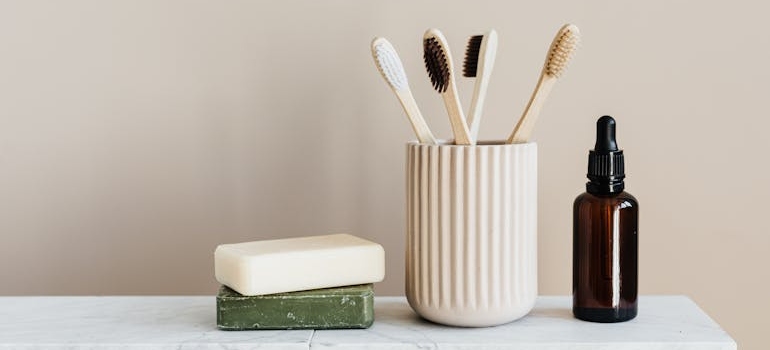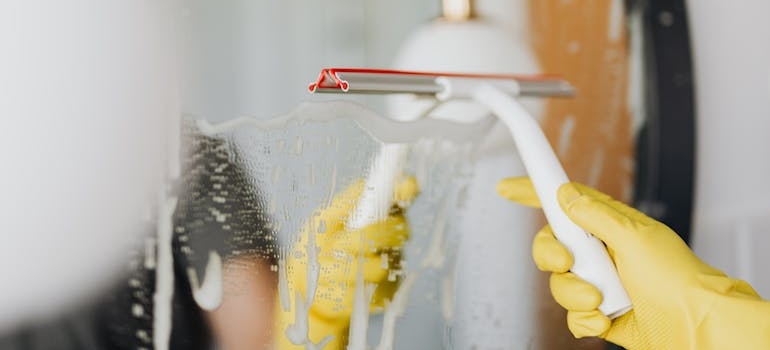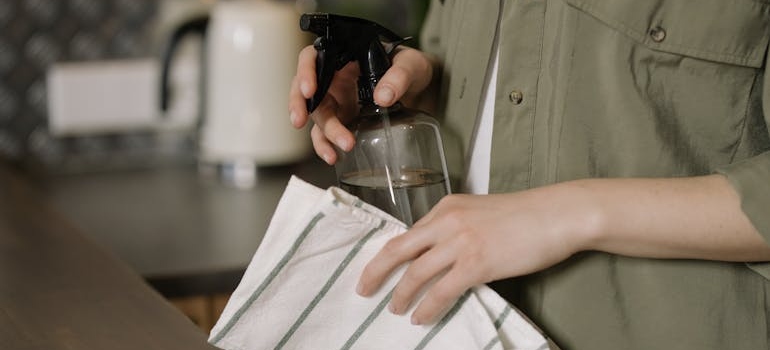Green Cleaning in Your New Seattle Home
Moving to the SMA soon? It’s the perfect time to start green cleaning in your new Seattle home. Swap out harsh chemicals for eco-friendly alternatives that are better for your health and the environment. Traditional cleaning products often contain harmful chemicals that can negatively impact indoor air quality and contribute to environmental pollution. Our Seattle movers‘ guide will help you set up your new home with simple, effective, and sustainable cleaning methods. Make your Seattle home a clean, eco-conscious haven from day one!
What is Green Cleaning?
Green cleaning means using cleaning methods and products made with environmentally friendly ingredients designed to preserve human health and environmental quality. In other words, it avoids chemicals that can cause harm to people and the planet.
Differences Between Traditional and Green Cleaning Products
Traditional cleaning products often contain synthetic chemicals that can be toxic, causing skin irritation, respiratory issues, and environmental damage. On the other hand, green cleaning products use natural, biodegradable ingredients that are safer for you and the environment. They are free from harsh chemicals and often come in recyclable or compostable packaging.
Common Harmful Chemicals in Traditional Cleaners
Many conventional cleaning products contain harmful chemicals like ammonia, chlorine, phthalates, and triclosan. These substances can degrade air quality, contribute to respiratory problems, and persist in the environment, causing long-term ecological harm. Green cleaners avoid these ingredients, opting for safer alternatives like vinegar, baking soda, and essential oils.

Benefits of Green Cleaning
Embracing green cleaning offers comprehensive benefits, enhancing your health, protecting the environment, and saving money. Besides, a sustainable approach aligns with a lifestyle that values well-being and ecological responsibility. And here’s how.
Health Benefits
One of the most significant advantages of green cleaning your new home after Washington movers help you move is—the health benefit. Traditional cleaning products often contain toxic chemicals that can cause a range of health issues, from skin and eye irritation to respiratory problems and hormonal disruptions.
Switching to green cleaning products reduces your exposure to these harmful substances. Natural ingredients like vinegar, baking soda, and essential oils clean effectively without posing health risks, making your home safer for everyone, especially children and pets.
Environmental Benefits
Sustainable cleaning products are designed to be environmentally friendly. They contain biodegradable ingredients that break down naturally, reducing the impact on the ecosystem. Traditional cleaners, in contrast, can release pollutants into the air and water, contributing to environmental degradation.
Supporting eco-friendly companies that prioritize sustainable practices, from sourcing ingredients responsibly to using recyclable packaging, reduces pollution and conserves resources. Such choices further lead to a healthier planet.
Economic Benefits
While green cleaning products can sometimes be more expensive upfront, they often lead to cost savings in the long run. Many green cleaning solutions are multi-purpose, reducing the need to purchase multiple specialized products.
DIY cleaning recipes using inexpensive household items like vinegar and baking soda are highly effective and budget-friendly. Additionally, green cleaning your Seattle home can extend the lifespan of household items by being less abrasive, reducing the need for replacements. Over time, these savings add up, making green cleaning a financially smart choice.

Essential Supplies for Green Cleaning in Your New Seattle Home
Creating a green cleaning arsenal for your home involves stocking up on a few key ingredients and tools that are both effective and environmentally friendly. Here are some essential green cleaning products and tools to get you started:
- Vinegar: A natural disinfectant that can clean glass, countertops, and more.
- Baking Soda: Great for scrubbing surfaces and neutralizing odors.
- Castile Soap: A versatile, plant-based soap that can be used for various cleaning tasks.
- Essential Oils: Add a few drops for a pleasant scent and additional antibacterial properties. Lemon, tea tree, and lavender are popular choices.
- Hydrogen Peroxide: A non-toxic bleach alternative for disinfecting and whitening.
- Olive Oil: Can be used to polish wood and clean stainless steel.
With these powerful and eco-friendly cleaning agents on hand, it’s important to pair them with the right tools to maximize their effectiveness. The right equipment ensures that your green cleaning routine is not only efficient but also sustainable:
- Reusable Cloths: Replace paper towels with microfiber cloths or old cotton rags that can be washed and reused.
- Biodegradable Sponges: Choose sponges made from natural materials like cellulose.
- Spray Bottles: Refillable bottles for your homemade cleaning solutions, ideally made from recycled plastic or glass.
- Scrub Brushes: Opt for brushes with wooden handles and natural bristles.
- Bucket and Mop: A sturdy, reusable mop and bucket set, preferably with a detachable and washable mop head.
Stocking your home with these green cleaning supplies helps ensure that your cleaning routine is effective, safe, and environmentally responsible!
Green Cleaning Recipes
Crafting your own cleaning solutions is a cost-effective and eco-friendly way to keep your new Seattle home spotless. As you settle in and unpack your moving boxes in Seattle, here are some simple, effective DIY recipes for various surfaces:
All-Purpose Cleaner
- Ingredients: 1 cup water, 1 cup white vinegar, 10-15 drops of essential oil (lemon, lavender, or tea tree)
- Instructions: Combine the ingredients in a spray bottle and shake well. Use this solution to clean countertops, sinks, and other surfaces.
- Storage: Store in a cool, dark place and label clearly with the date made. Use within a few months for best results.
Glass Cleaner
- Ingredients: 1 cup water, 1 cup white vinegar, 1 tablespoon cornstarch
- Instructions: Mix the ingredients in a spray bottle and shake to combine. Spray onto glass surfaces and wipe with a microfiber cloth for streak-free shine.
- Storage: Shake well before each use as the cornstarch can settle. Label and store away from direct sunlight.
Bathroom Cleaner
- Ingredients: 1 cup baking soda, 1 cup white vinegar, 1 cup water, 10 drops tea tree essential oil
- Instructions: Sprinkle baking soda on bathroom surfaces like tubs and sinks. Spray the vinegar and water mixture over the baking soda. Let it fizz for a few minutes, then scrub and rinse thoroughly.
- Storage: Keep the vinegar and water solution in a labeled spray bottle. Store baking soda in an airtight container.
Floor Cleaner
- Ingredients: 1 cup white vinegar, 1 gallon warm water, a few drops of essential oil (optional)
- Instructions: Mix the ingredients in a bucket. Mop floors as usual, ensuring the mop is damp rather than soaked to avoid excess water on floors.
- Storage: This mixture is best prepared fresh each time, but the vinegar and essential oils can be stored separately and labeled.
Wood Polish
- Ingredients: 1 cup olive oil, 1/4 cup lemon juice
- Instructions: Combine the ingredients in a jar and shake well. Apply a small amount to a soft cloth and rub it onto wood surfaces in the direction of the grain. Buff with a clean, dry cloth.
- Storage: Store in a cool, dark place and label. Shake before each use and use within a few months.
Storing and Labeling Homemade Cleaners Safely
It’s essential to store your homemade cleaners properly to maintain their effectiveness and ensure safety. Use clean, recycled spray bottles and jars. Label each container with the name of the cleaner, ingredients, and the date it was made. That helps you keep track of freshness and avoid using expired products. Keep all cleaning solutions out of reach of children and pets, ideally in a cool, dark place to preserve their potency.

Room-by-Room Guide
Transitioning to green cleaning in your new Seattle home can be straightforward and rewarding. Here’s a room-by-room guide to help you get started once you’re done with Seattle moving services and preparing to settle in.
Kitchen
Green cleaning in the kitchen involves using natural ingredients to maintain a spotless environment. For countertops, use your all-purpose cleaner. Spray the solution on surfaces and wipe with a reusable cloth daily to prevent buildup. Clean appliance exteriors weekly with the same solution.
For ovens, apply baking soda, spray with vinegar, let it sit and fizz, then scrub clean every few months or as needed. Mop floors weekly with your floor cleaner, a mixture of vinegar and water. For sinks, sprinkle baking soda, spray with vinegar, let it fizz, then scrub and rinse to keep them sparkling.
Bathroom
In the bathroom, tackle tough spots with your green cleaning methods. Clean tiles and grout monthly using a paste of baking soda and water; apply to grout lines, spray with vinegar, and scrub after the fizzing stops. For toilets, pour your bathroom cleaner of baking soda and vinegar into the bowl weekly. Let it sit for 10 minutes, scrub, and flush. Showers and tubs can be cleaned weekly by spraying them with your bathroom cleaner of water and vinegar, letting them sit, and then scrubbing.
Living Areas
Dust living areas weekly using a microfiber cloth to trap particles. Polish wood furniture monthly with your wood polish, a mix of olive oil and lemon juice, to clean and nourish wood. When vacuuming, use a machine with a HEPA filter to capture dust and allergens, doing this at least weekly. For upholstery, sprinkle baking soda, let it sit for 15 minutes to absorb odors, then vacuum thoroughly every few months or as needed.
Bedrooms
Keep bedrooms clean and fresh by washing bedding weekly with eco-friendly detergent. Freshen mattresses monthly by sprinkling baking soda, letting it sit for 30 minutes, then vacuuming. Dust furniture weekly with a microfiber cloth. Clean floors with your floor cleaner of vinegar and water solution weekly to ensure all surfaces are free from dust mites and allergens.
Laundry Room
In the laundry room, choose green detergents free from harsh chemicals. For regular laundry, use eco-friendly detergent with every wash. Pre-treat stains with a baking soda paste or soak in a vinegar-water solution as needed. These methods are effective yet gentle on fabrics, extending their life and maintaining quality.
Techniques for Green Cleaning in Your New Seattle Home
Using the right technique for each surface ensures maximum effectiveness with minimal effort.
- For hard surfaces like countertops and tiles, spray your all-purpose cleaner and wipe with a reusable cloth.
- For glass, use a microfiber cloth with your glass cleaner to avoid streaks.
- On wood surfaces, apply wood polish with a soft cloth and buff to a shine.
- For fabrics, sprinkle baking soda, let it sit to absorb odors, then vacuum thoroughly.
These methods leverage the natural cleaning power of green products without leaving residues!
Tips for Reducing Water and Energy Use While Cleaning
To minimize energy consumption and water use, adopt efficient practices. Use concentrated cleaning solutions and dilute them as needed, which reduces packaging waste and the volume of products you store. When mopping floors, use a damp mop instead of soaking it, which conserves water. Opt for cold water in your washing machine whenever possible, and air-dry clothes to save energy. Regularly maintain appliances to ensure they run efficiently, further conserving energy.
Proper Ventilation Practices to Improve Indoor Air Quality
Proper ventilation is crucial in maintaining good indoor air quality, especially when cleaning. Open windows and doors to allow fresh air to circulate and help dissipate any fumes from cleaning products, even green ones. Use exhaust fans in bathrooms and kitchens to remove moisture and prevent mold growth. Additionally, houseplants can improve air quality by absorbing toxins and releasing oxygen.

Green Cleaning Challenges and Solutions
Stubborn stains and mold can be challenging to tackle without harsh chemicals, but natural solutions are effective. For tough stains on fabrics, create a paste of baking soda and water, apply it to the stain, and let it sit before washing. For mold, spray the affected area with vinegar, let it sit for an hour, then scrub with a brush.
Managing Pests with Eco-Friendly Options
Did you know that eco-friendly pest control involves using natural deterrents and maintaining a clean environment?
- For ants, sprinkle diatomaceous earth around entry points.
- For flies, use traps made from apple cider vinegar in a bowl covered with plastic wrap with small holes.
- For rodents, peppermint oil on cotton balls placed in entry points can deter them.
Regularly clean and store food properly to avoid attracting pests.
Overcoming Resistance to Change from Traditional to Green Cleaning
Transitioning from traditional to eco-friendly cleaning can face resistance due to habits and misconceptions. Start by educating your household on the benefits of sustainable relocation for health and the environment. Introduce green products gradually, replacing traditional ones as they run out.
Demonstrate the effectiveness of green cleaning in your new Seattle home by tackling a particularly dirty area with natural products and showcasing the results. Sharing testimonials and tips from others who have successfully made the switch can also be motivating!
Why Choose Us
History
Hansen Bros. Moving & Storage is locally owned and operated by the same family for four generations, since 1890. We have a well-established reputation for service quality and reliability with a high percentage of repeat household and commercial clients.
Professionalism
We’re a certified ProMover by the American Moving and Storage Association with A+ rating with the Better Business Bureau, voted “Best in Western Washington” in 2009 and from 2011 to 2016 by KING5. Our company is fully licensed and insured and member of WMC and AMSA.
Value
Hansen Bros. Moving & Storage provide free, no-obligation in-home estimate and competitive rates, including low minimum rates for shipments moving under 300 miles. We’ve set a refund policy for unused packing materials and three Puget Sound locations to help clients save on travel fee costs.



